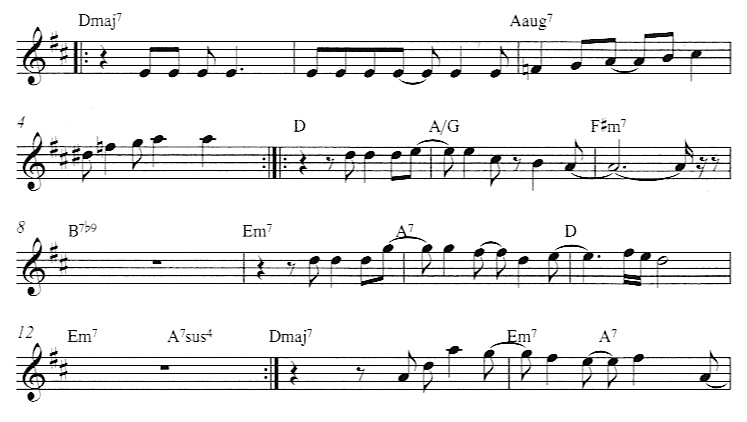Lesson Seven – Moving Ahead
Here are the chord progression examples as shown in the video :
1, 2, 6, 4, 5 1, 6, 4, 5 1, 4, 5
Other common chord progressions can include:
1, 5, 6, 4 1, 3, 4, 5 1, 2, 5 1, 5 1, 4
You’ll notice that all these chord progressions consist of the natural chords found in the major scale as discussed in lesson three. This means that we can use the modal and chordal lesson techniques over any of these progressions, which are exactly how most popular songs are constructed.
Also note that in most music charts we use the Roman numerals to notate chordal degrees:
1= I 2= II 3= III 4= IV 5= V 6= VI 7= VII
So a typical notated chord progression of 1 6 4 5 would look like this: I VI IV V
Know Your Chords!
To continue ahead with your improvisation journey you must really grasp the concept of chords. This is not complicated. As you have seen in lesson three and above, there are only 7 chords to deal with.
The one, four, and five chords are usually the most common in most songs and are hi lighted in blue to the right. The minor chords are usually secondary, these are the two, three, six and seven which is a double minor, meaning both it’s 3rd and 5th intervals are both minor which makes it a diminished chord and is used less than the others..
Once you learn this you’ll be able to analyze most any song you come across.
Test Yourself!
Identify these song’s keys and numerical chord progressions
Most times a song will start and end with the one (tonic) chord. Other signs are the 5 chord. So if you think the song is in C major look for some G and G7 chords, these are the 5 chord and they are used in almost every song. Remember as stated above, the two, three and six chords can be common as well.
Have a look through the chord progression of “Let It Be” and “You Are The Sunshine Of My Life” to the right. Identify the song’s key and chord progression. Write it out in proper numerical numbers like you saw in the lesson videos: 1, 4, 2m, 5M etc.
Then compare your findings with mine which I’ve included in the tabs below.
*Note – Don’t worry about the chord extensions such as maj7 and aug7 etc. Just look at the main chord name because extensions are just used to decorate the chord.
Click the song’s tab to see the correct chord progression
Key of C major
line 1: | 1 | 5 | 6m | 4 | 1 |
line 2: | 5 | 4 | 1 | 1 | 6m | 3m |
line 3: | 4 | 1 | 1 | 5 | 4 | 1 |
Key of D Major
line 1: | 1maj7 | 1maj7 | 5aug7 |
line 2: | 5 | 1 | 5/4 | 3m7 |
line 3: | 67b9 | 2m7 | 57 | 1 |
line 4: | 2m7 57sus4 | 1maj7 | 2m7 57 |
Bottom Line…
The bottom line is that most pop songs are harmonically simple. What this means for you is that learning the lessons taught in this course will prepare you to be able to improvise over many many songs.
So go back and practice those modes and scales. Learn one key REALLY WELL and then move on to another key.
Closing Thoughts…
There are many more ways to use and explain modes. Most people don’t really understand them and so can’t use them. Jazz musician’s have more complex ways to improvise using them in different situations. What I’ve shared with you here is a straight forward approach that will enable you to get to know them and actually use them to improve your ability to improvise.
Is this it? No. In music there is always more to learn or another way to learn it. But as for beginning a journey into simple improvisation techniques this should be enough for you, at least for a while until you really grasp these lessons.
If you do move on to other songs, remember to analyze them first so you know what all the chords are. From there you will know what to do. It may still seem overwhelming now, but as you learn and memorize the modes and chords it becomes easier, and therefor ultimately more fun… and you’ll start to sound better!
cheers and good Luck!
Johnny Ferreira




